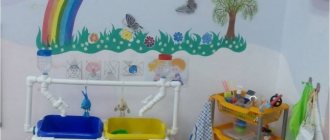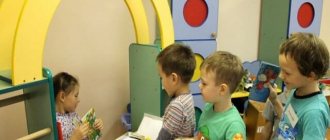Play as a means of speech development in preschool children
Play as a means of speech development in children
preschool age
In the system of education and training of preschool children, play occupies an important place - the leading activity of the preschool period, creating the most favorable conditions for the mental and personal development of the child. In the game, a preschooler, unnoticed by himself, acquires new knowledge, skills and abilities, learns to carry out search actions, think and create.
With the help of didactic games, children develop speech: the vocabulary is replenished and activated, correct sound pronunciation is formed, coherent speech develops, the child learns to express his thoughts correctly.
Speech
- this is the most important mental function of a person, without which a person would not be able to receive and transmit a large amount of information.
Good speech
- the most important condition for the comprehensive development of children, this is the key to the successful education of children at school.
The formation of correct speech is one of the main tasks of preschool education. Speech activity is unthinkable without cognition, without the child mastering the surrounding world.
The idea of including didactic games in the learning process has always attracted domestic teachers. Even K. D. Ushinsky noted that children learn new material more easily during play, and recommended trying to make classes more entertaining, since this is one of the main tasks of teaching and raising children.
Many scientists note the important role of educational games, which allow the teacher to expand the child’s practical experience and consolidate his knowledge about the world around him.
A didactic game is a valuable means of cultivating mental activity; it activates mental processes and arouses a keen interest in the process of cognition in preschoolers. The game helps to make any educational material exciting, causes deep satisfaction in children, stimulates performance, and facilitates the process of assimilation of knowledge.
Didactic games
is a type of game with rules, specially created by adults for the purpose of teaching and raising children. They are aimed at solving specific problems in children’s education, but at the same time, they demonstrate the educational and developmental influence of gaming activities. The widespread use of didactic games in preschool educational institutions is explained by the fact that they best suit the strengths and capabilities of preschoolers, because learning in the form of play is based on the child’s desire to enter an imaginary situation and act according to its laws.
The inclusion of games in the pedagogical process of preschool educational institutions is due to their characteristics; they clearly demonstrate the relationship between exciting gaming activities and the process of children’s assimilation of ideas and knowledge. In games, a child, without pressure, without deliberate training, learns to observe and highlight the features of various objects.
With the help of games, educational tasks are solved in developing children’s mental activity skills and the ability to use acquired knowledge in new situations. When playing, children remember cognitive material better than when they are asked to simply memorize. The goal of the game mobilizes attention, thinking, and memory. In play, the child not only gains new knowledge, but also generalizes and consolidates it. Preschoolers develop cognitive processes and abilities, they assimilate socially developed means and methods of mental activity.
The educational and developmental value of teaching in the form of a didactic game lies in the content and focus of it on solving the problems of moral education - nurturing a positive attitude of children towards the phenomena of life around them, towards work, relationships between people, nurturing respect for family and elders.
Types of children's games
Games - travel
designed to enhance the impression, to draw children's attention to what is nearby. They sharpen observation and demonstrate overcoming difficulties. These games use many ways to reveal cognitive content in combination with gaming activities: setting problems, explaining how to solve them, solving problems step by step, etc.
Errand games
simpler in content and shorter in duration. They are based on actions with objects, toys, and verbal instructions.
Games - guesses
("what would happen if..."). Children are given a task and a situation is created that requires comprehension of the subsequent action. At the same time, children’s mental activity is activated, they learn to listen to each other.
Riddle games
. They are based on testing knowledge and resourcefulness. Solving riddles develops the ability to analyze, generalize, and develops the ability to reason and draw conclusions.
Conversation games
. They are based on communication. The main thing is spontaneity of experience, interest, and goodwill. Such a game makes demands on the activation of emotional and mental processes. It develops the ability to listen to questions and answers, focus on the content, supplement what is said, and express judgments. Cognitive material for this type of games should be given in an optimal volume, be accessible and understandable in order to arouse the interest of children. Cognitive material is determined by the lexical topic and the content of the game. The game, in turn, must correspond to the mental capabilities of children.
One of the main tasks is to choose such game options to arouse children’s interest in word games. In all classes and routine moments, the teacher needs to include speech didactic games and entertaining exercises: phonetic, lexical, grammatical, games with words and movement. In order for children to show interest in a game again, it is very important to pay attention to how to finish the game. This could be playing forfeits, honoring winners, announcing a new version of a familiar game, etc.
You can start games with articulation exercises, pronouncing all kinds of tongue twisters, tongue twisters, and rhyming lines to develop the speech apparatus.
Particular attention, according to pedagogy scientist O.V. Nikonova, should be paid to the rules of the game. Their content and focus are determined by the general tasks of forming the child’s personality, cognitive content, game tasks and game actions. The rules contain moral requirements for the relationships between children and for their compliance with norms of behavior. In a didactic game, the rules are given. With the help of rules, the teacher controls the game, the processes of cognitive activity, and the behavior of children. The rules also influence the solution of the didactic task - they imperceptibly limit the actions of children, direct their attention to fulfillment
Thus, preschool age is a fertile time for speech development. To become highly educated, a person must master all the riches of his native language. The use of didactic games in the work of a teacher contributes to the development of children’s speech activity and to increasing the effectiveness of correctional work. It must be remembered that the development of preschoolers’ speech during play activities is an attempt to teach children lightly, joyfully and without coercion.
Child Game
has a certain structure.
Structure is the basic elements that characterize the game as a form of learning and gaming activity at the same time.
Didactic task
determined by the purpose of teaching and educational influence. It is formed by the teacher and reflects his teaching activities. For example, in a number of didactic games, knowledge, skills, and abilities are consolidated in accordance with program objectives.
The game task is carried out by children. The didactic task in a didactic game is realized through a game task. The game task determines the game actions and becomes the task of the child himself. The most important thing: the didactic task in the game is deliberately disguised and appears before the children in the form of a game plan (task).
Game actions
- the basis of the game. The more varied the game activities, the more interesting the game itself is for children and the more successfully cognitive and gaming tasks are solved. In different games, game actions differ in their focus and in relation to the players. This, for example, could be role-playing activities, solving riddles, spatial transformations, etc. they are related to and derived from the game design. Game actions are means of realizing the game plan, but also include actions aimed at fulfilling the didactic task.
Rules of the game
. Their content and focus are determined by the general tasks of forming the child’s personality, cognitive content, game tasks and game actions. The rules contain moral requirements for the relationships between children and for their compliance with norms of behavior. In a didactic game, the rules are given. With the help of rules, the teacher controls the game, the processes of cognitive activity, and the behavior of children. The rules also influence the solution of the didactic task - they imperceptibly limit the actions of children and direct their attention to implementation.
The game develops the moral habits of children, creates the opportunity to show initiative, independence, and activity in solving game problems and performing game actions. In addition to speech development, cognitive development is carried out in the game, since the game helps to expand ideas about the surrounding reality, improve attention, memory, observation and thinking.
The purpose of the didactic game
- implementation of didactic and gaming tasks. The didactic task is aimed at concretizing, clarifying, and systematizing knowledge; mastering methods of mental and practical activity; nurturing a moral attitude towards objects and phenomena of the objective, natural and social environment; for a deeper study of the individual characteristics of their peers and themselves. The didactic task is determined by the adult. For children, the goal of the game appears in the form of a game task, which is sometimes included in the title of the game - “Where, whose house,” “Find out by sound?” and encourages action.
Reducing the goal of a didactic game only to solving a didactic problem impoverishes its educational and developmental potential and often brings it to the level of a didactic exercise. A.V. Zaporozhets especially emphasizes its general developmental nature, its influence on the development of intellectual, communicative, and social special abilities. The effectiveness of using didactic games in the pedagogical process is determined by the competent correlation of didactic and educational tasks. Taking into account the child’s state of thinking and his capabilities, it is necessary to set tasks in didactic games that ensure the activation of all mental functions. Most studies note the enormous educational potential of didactic games in sensory and intellectual development.
Principles for constructing a system of didactic materials:
1. Didactic materials must be specially designed in such a way as to technically ensure the recreation of a genuine game situation and, when playing, to turn off the appearance of extraneous motives for activity. They should be colorful and attractive.
2. The system of materials should consist of manuals both for the play of an individual child and small children's groups in order to occupy the entire kindergarten group at the same time.
3. Didactic materials should be dynamic and include children’s favorite manipulations, stimulating perceptual actions and satisfying the need for cognitive activity, causing movement (putting in and out, hitting the target, examining and selecting the right one, etc.).
4. Didactic material should be designed with the intention of forming vital functional mental structures and include the moment of internal independent activity of each child to solve the problem.
5. Didactic material should make it possible to build pedagogical work with small groups of children with the methodological gradualism that is required to master both one or another individual aspect of the subject, and the differentiated structure of the subject as a whole.
6. Didactic materials and game situations should include the possibility of repeating this type of mental activity in varying conditions in order to consolidate the emerging mental structure and so that the acquired structures manifest themselves in changing life conditions.
7. In a game situation, mutual control and self-control of the correctness of the problem solution must be ensured.
One of the significant achievements of preschool children in mastering games is the inclusion of elements of creativity and joint planning of actions: the development of new rules, the content of the game, the introduction of ritual, educational elements, etc.
Thus, the use of games in the work of a teacher contributes to the development of children’s speech activity and to increasing the effectiveness of correctional work. It must be remembered that the development of preschoolers’ speech during play activities is an attempt to teach children lightly, joyfully and without coercion. In the process of playing, children better learn what is difficult in everyday life.
Conclusion.
Play is the main way to develop coherent speech in older preschoolers, since it is more attractive to children and children engage in it with more pleasure than, for example, just studying at school. Through play, you can develop a child’s cognitive characteristics, prepare him for life in modern society, and make him believe in his strengths and capabilities. The teacher’s task is to find the maximum of pedagogical situations in which the child’s desire for active speech activity can be realized. The teacher must constantly improve the learning process, allowing children to effectively and efficiently assimilate program material. Therefore, it is so important to use game elements and games as a means of developing coherent speech in preschool children.





